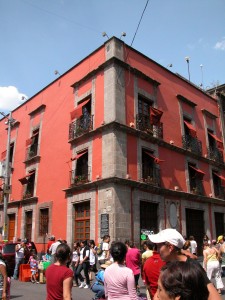(April 25, 2011) As you can see, I haven’t posted any writings in a while. Ambitious plans to write informative posts on psychiatry and mental wellness have been sidelined by an excessive work schedule of clinic appointments, hospital calls, and other clinical commitments. But providing quality care means more than just seeing patients. It also involves continuing to grow and evolve as a psychiatrist, to learn the latest advances in psychiatric medicine, and to broaden one’s perspective on social and cultural aspects of mental wellness.
And that brings me to Mexico City. First, it’s a much needed vacation. Second, it’s a chance for me to understand better the patients that I see who are of Mexican origin. I planned this trip thinking that, not having much time, Argentina or Spain are too far. La Ciudad de Mexico is the closest major Spanish-speaking city to Houston. Plus, it has a long, at times tragic, and fascinating history that dates back two millenia before the Spanish conquest (historia prehispana). But I must confess that as the day approaches for this trip, I became increasingly nervous. Nearly everyone that I met, including Mexicans, warned me of the dangers and seemed to think that I might be kidnapped or killed. Mexico is a dangerous place, they say. Surely, I thought, the warnings are exaggerated. Even if 10 people were killed every day in Mexico City, this is a city of over 20 million people (too many other potential targets, as they say). Besides, I have always felt comfortable with Mexicans and speak Spanish well enough to get by.
Today, my fourth day here in Mexico City, I feel fairly comfortable here. Walking around near the city center, on the Paseo de la Reforma, in the Bosque de Chapultepec, these places all feel pretty safe. I have met many friendly and helpful Mexicans who try to make me feel welcomed here. Clearly, the people live their lives differently than Americans. In general, they are more social and in many ways more open. It is a society of contrasts, of extreme wealth and extreme poverty, but Mexico is not a poor country.
Arriving during Semana Santa (the week before Easter), the city was quieter than normal. The air was less contaminated with vehicular exhaust and quite breathable. I was able to see the tall mountains surrounding the city. But I saw very few Americans, actually almost none at all. It would appear that Americans, and foreign tourists in general, have decided to stay away from Mexico because of fears of violence. I believe that these fears are overstated.
These fears are probably more rooted in our psychology than on the actual facts. Our mind magnifies events that are high impact, yet of very low probability. Also, the fears may be related to our fears of all things foreign, which we term xenophobia. Foreign elements have the capability to harm us, so our instinct is to stay away from them. This is true whether they be foreign people, animals, plants, or things. But we also have a counteracting instinct that draws us toward novelty. This instinct leads us to explore and experience new sights, sounds, and smells. It leads us to discover and to understand that which is unknown. There is a biological need for novel genetic elements (i.e., foreigners to reproduce with). To survive, all populations need an influx of new genes, which enhances the genetic diversity of species and ensures their survival in the face of catastrophic change.
I count myself among the more novelty-seeking. In Mexico City, along parks and near bus stations, there are many stalls selling snacks, fruit, candies, drinks, all sorts of stuff. I wanted to look at everything, taste everything. If you go there, don’t be afraid of trying mangoes with lime, salt, and chilies. In Vietnam, we like to eat it this way too (more the green mangoes though) and it’s very tasty.
Time-permitting, over the next few months, I will write some articles about sleep, why we need it and how to improve it.



